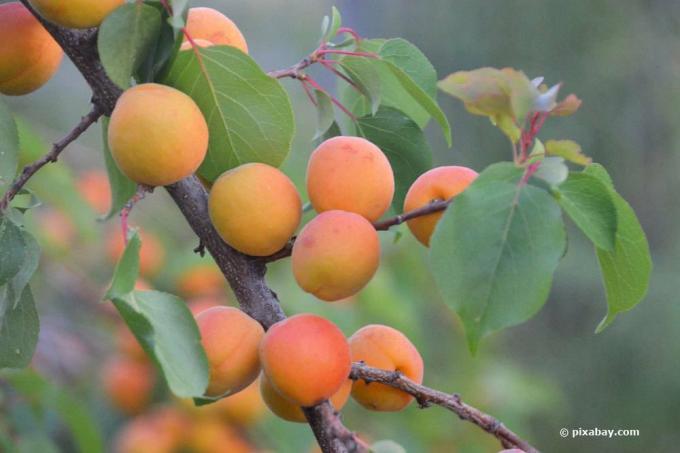
table of contents
- Apricot tree
- Best time
- Maintenance cut: Instructions
- Trellis cut
- Upbringing
- Conservation cut
- Cut back
Of the Apricot tree, also known as the apricot tree, is one of the most popular fruit trees in Germany and a welcome guest in the garden due to its juicy fruits. When caring for the apricot, the cut and the time at which it is cut are particularly important. This is the only way that the apricot can maintain its vitality, which has an impact above all on the fruit and the possible harvest yield. You shouldn't neglect cutting.
Apricot tree
Why cut
The apricot tree (bot. Prunus armeniaca), like many other fruit trees, has to be pruned in order to provide the flowers, fruits and leaves with sufficient sun, air and light. The annual pruning measures thinning the crown to provide space for new shoots and to keep the shape. Wild growth, which can reduce the yield in the long run, is prevented and you can look forward to the sweet apricots from the beginning of July to the end of August. The roots can only supply a certain number of branches with the necessary nutrients, which can lead to poor fruits and possible diseases without cutting.
Tip: Is the location of your apricot tree very clayey? Then the annual pruning is even more important, as the apricot grows extremely quickly due to the high nutrient intake and can quickly lead to problems.
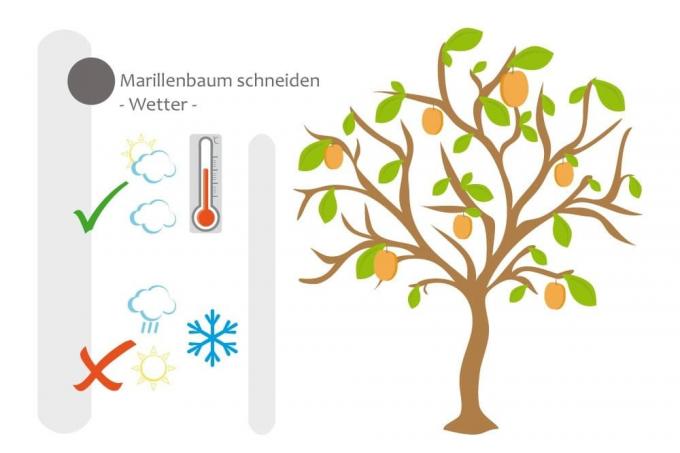
Best time
The timing of the pruning is particularly important so that the apricot tree has enough time to recover and to regain sufficient plant parts. There are actually two dates in the year when the cut can be made.
After harvest
Typically, an apricot tree is always cut after harvest. More precisely, this means the period from the beginning of August to mid-October. The exact time depends on the harvest. The later you pick the apricots, the tastier they become because they are extremely ripe. However, the earlier the fruit is harvested, the longer the shelf life increases. It is important to note with this cut that it must be made early enough. This means that there must be no danger of frost, otherwise the cuts can no longer heal properly and the tree becomes sick.
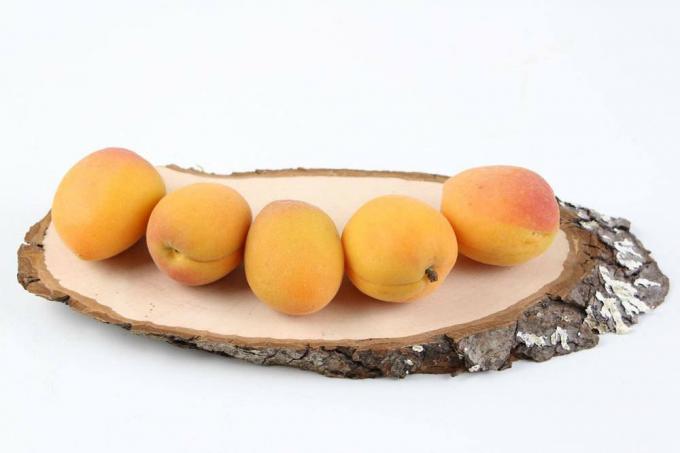
Winter pruning
Cutting in winter is often offered as an option if the cut is missed in summer or autumn. The period here would be mid-March to mid-April on frost-free days. However, the winter pruning should be carried out with great care, as rapid frosts in spring are unfavorable for the apricot tree. As such, this cut may only be made if there is an emergency and the apricot tree is so large that its health would suffer from the amount of plant material.
First frost
If you prune your apricot tree immediately after harvesting and watch out for the first frosts, you are sending the tree perfectly prepared for the winter. If you harvest the apricot tree, the wound will heal faster and Prunus armeniaca will thank you with numerous flowers and fruits in the following year. The cut should also be made early enough if the apricot tree is close to a house wall. Since it grows quite quickly, the important plant material can be damaged if it comes into contact with the wall, which has a strong effect on the growth of the plant.
Maintenance cut: Instructions
The maintenance pruning is the be-all and end-all for the preservation of the plant and the apricot tree will not hold it against you if you prune it annually. The pruning of the apricot is more than a thinning because it doesn't really need pruning. This is because the species has adapted well to the living conditions in Germany and has extremely strong growth. The right tool is particularly important for the cut.
- Pruning shears or pruning shears, depending on the age of the plant
- Head, depending on the height of the plant
- Wound closure agents

You do not need gloves or the like for this fruit tree, but be sure to use the scissors before using disinfect. If you don't do this, pathogens from previous cuts can spread to the apricot tree and make it sick. That Wound closure agents is only used if major wounds occur during the incision that need to be treated. This is not necessary for small wounds and can even be harmful due to water retention, which in turn could lead to a fungal attack. For the cut, proceed as described below.
1. Step:
Start by looking at the tree. What is the shape? Where can you find branches that grow against the shape? When pruning an apricot tree, it is important that it retains a shape that does not restrict growth. This means that branches that are too long, which could hit fences, walls or other trees or simply do not fit into the picture of the tree, must be removed or cut down to the actual crown. Cut these off just above buds.
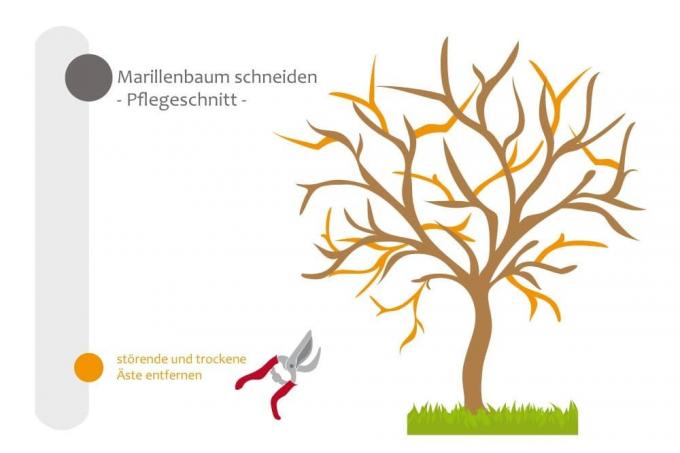
2. Step:
Then remove all shoots and branches that are either dead, dried up or too weak and only use up nutrients unnecessarily. These should be completely cut down to the main shoot or the next side shoot.
3. Step:
Now look for the shoots growing inside. These are also annoying, as they restrict growth and hardly get any light. Especially in dense crowns, these branches are often too weak and use valuable energy that the apricot tree could use for blossoming and fruiting. Also cut this completely down to the next larger branch.
4. Step:
Crossing shoots must also be removed. These can stand in the way of the fruit-bearing branches or hinder them due to their weight. Also remove up to the next larger shoot.

5. Step:
Under no circumstances should you forget the competing instincts. These are large shoots that run parallel to the trunk and, if ignored, grow so strongly that the tree has two trunks. This creates nutrient problems for everything, as the roots end up having to support two trunks.

6. Step:
An apricot tree often has water shoots. These are shoots that resemble a broom and must be removed in any case.
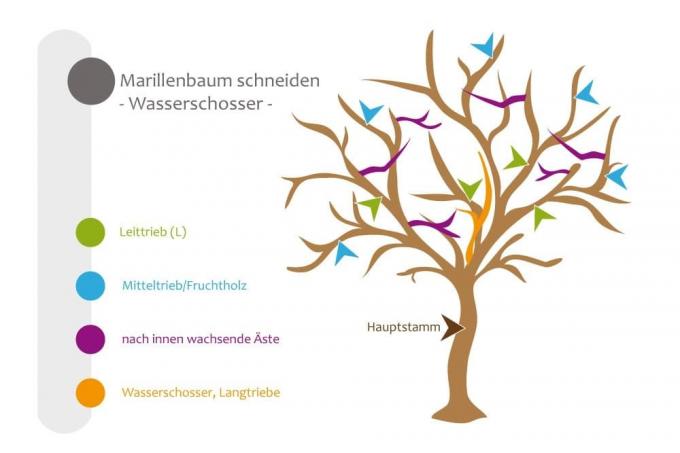
7. Step:
You can carefully trim the rest of the crown to keep the shape. It is best to aim for a compact crown that is supported by many branches and somewhat resembles a roof. When doing this pruning measure, make sure that you only remove a small part of the tips of the branches and shoots so that the apricot tree appears airy.
8. Step:
It is best to orientate yourself on the foliage. The trimmed branches should still have enough leaves, as they are not completely removed. Less is more with the apricot tree! Always keep this in mind.
9. Step:
Finally, consider the interfaces and treat particularly large ones with the wound closure agent. Then dispose of the cut parts of the plant and continue with the usual care measures.
Trellis cut
Cut the apricot tree on the trellis
Apricot trees are often grown on trellises because, like apples and pears, they are perfect for this type of keeping. The cut is carried out differently for this purpose in order to meet the requirements of the plant. Several types of pruning are carried out at different stages in the life of the plant.
Upbringing
The education cut is the first cut with which the apricot tree is brought into the right shape for the climbing aid. This is applied for the first two years at the beginning of July. In this one, choose the strongest shoot, which will grow as a trunk from then on, and shorten the tip and all weak side shoots. Leave only the strongest shoots that grow out of the main shoot. However, trim them back to four to six sheets in length.
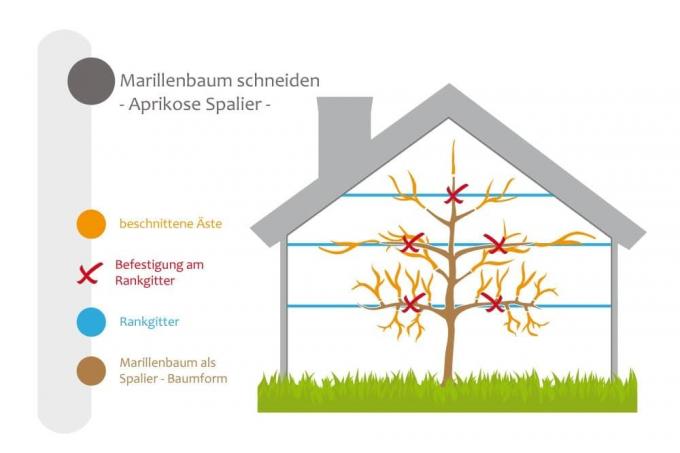
Conservation cut
The maintenance pruning is mainly used to remove dried up and old shoots. In addition, the desired form is introduced via this. With this cut, you ensure a balanced balance between the main and fruit shoots that emanate from the main shoot. This cut can also be viewed as a maintenance cut.
Cut back
The pruning takes place from the third year and here make sure that the side branches of the apricot tree grow horizontally and keep this shape. To do this, cut off strongly branching shoots.
With these Cutting measures you can effectively shape your apricot tree on the trellis and use a decorative plant a lot of harvest potential be happy. You also ensure that it does not grow too big too quickly, which is not good for the apricot's growth at all.

